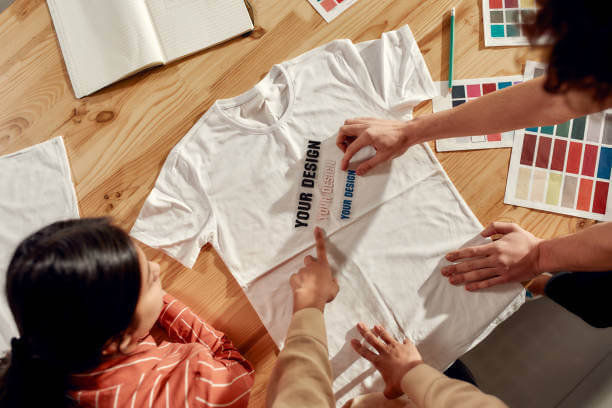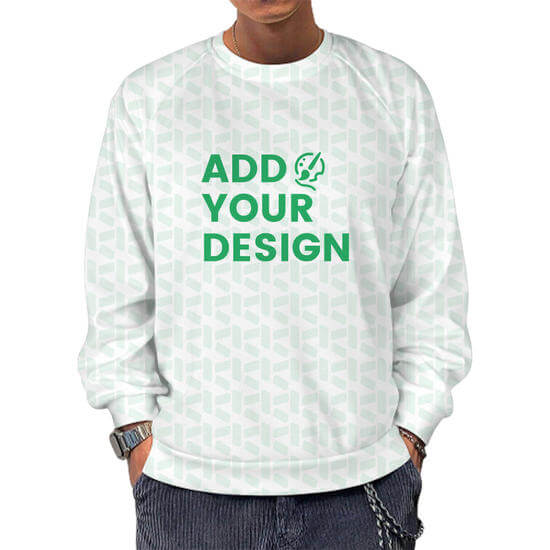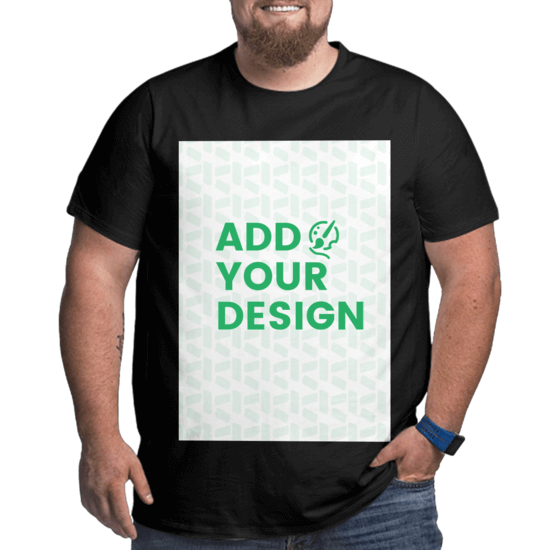
Welcome to the 2024 ultimate guide on crafting custom clothing from scratch. Tailored for designers, entrepreneurs, and fashion enthusiasts, this blog is your go-to resource for diving into the world of custom fashion.
We cover everything from selecting your niche to utilizing top Print on Demand platforms like Printify and Printful, and effectively marketing your brand. Designed to transform your fashion ideas into reality, this guide equips you with the essential tools and insights for success in the dynamic world of custom clothing. Let's embark on this journey of fashion innovation together!
What Is Custom Clothing?
Custom clothing represents more than just garments tailored to fit. It embodies a personal touch, a unique flair that sets it apart from off-the-rack options. In this era of personalization, custom clothing allows individuals and brands to express their identity through fashion. This could range from a uniquely designed t-shirt that captures a personal motto, to an entire line of apparel reflecting a brand's ethos. The beauty of custom clothing lies in its diversity - it can cater to various styles, sizes, and preferences, making it a versatile choice for anyone looking to make a fashion statement.
The process of creating custom clothing involves various stages - from conceptualization and design to production and distribution. It offers a canvas for creativity, where designers and brands can experiment with different fabrics, patterns, and styles. Custom clothing is not just about the final product; it's about the journey of bringing a vision to life. This approach to fashion is increasingly popular among consumers seeking uniqueness in their wardrobe, as well as businesses wanting to stand out with branded apparel.
Why You Need to Make Your Own Clothing?
Making your own clothing goes beyond the boundaries of conventional fashion. It's a journey of creative expression and self-empowerment. In a world where fashion often conforms to certain standards, custom clothing allows you to break free and showcase your individuality. Whether it's a budding designer wanting to make a mark in the fashion industry or a business looking to create a unique brand identity, custom clothing offers a platform to differentiate oneself.
For small business owners and entrepreneurs, custom clothing can be an avenue to explore new markets or cater to niche audiences. It's an opportunity to create something that resonates with a specific demographic, be it through sustainable practices, unique designs, or culturally inspired themes. In addition, custom clothing can be a form of marketing, turning each garment into a walking billboard that showcases your brand. For designers and artists, it's a canvas to express creativity and potentially launch a fashion line that reflects their artistic vision.
How to Make Custom Clothing?

Creating custom clothing is an exciting venture that combines creativity with business acumen. To help you get started, let's delve into some popular Print on Demand (POD) platforms that can be instrumental in your journey. These platforms offer a range of services, from printing to fulfillment, and each has its unique strengths.
1. Choose a Good Niche:
Finding your niche is the first critical step in creating custom clothing. It's about identifying a segment of the market that not only interests you but also has potential demand. This could be anything from eco-friendly fashion to vintage reproductions or culturally inspired designs. The key is to find a niche that you are passionate about and that has an audience. Conducting market research, understanding customer preferences, and analyzing trends can help in pinpointing a niche that not only stands out but also has commercial viability.
2. Choose the Right Print on Demand Company:
Your choice of a print-on-demand (POD) company can significantly impact the quality and success of your custom clothing line. Factors to consider include the range of products offered, printing quality, pricing, and fulfillment services. Look for a company that aligns with your niche and can deliver high-quality products consistently. Additionally, consider their shipping times and customer service, as these aspects will directly affect your customer's satisfaction.
Let's explore a few options together:
- Printify: Known for its vast network of print providers and wide range of products, Printify allows you to choose the printer based on location, price, and product range. This flexibility can be a significant advantage in reducing shipping costs and times. Their user-friendly interface and integration with major e-commerce platforms like Shopify and Etsy make Printify a popular choice for entrepreneurs starting out in the custom clothing business.
- Gelato: Gelato excels in its global reach, offering local production in over 30 countries. This can be a huge advantage for businesses aiming for a global market, as it significantly reduces shipping times and costs. Gelato also prides itself on its commitment to sustainability, which can be a selling point if your brand is eco-conscious.
- Printful: Printful is another well-known player in the POD space, offering a wide range of products and robust fulfillment services. One of Printful's strengths is its branding options, allowing you to add custom labels and packing slips, giving a more personalized feel to your products. Their quality of print and material is also commendable, which is crucial for building a premium brand.
- PrintKK: While less known than the others, PrintKK offers unique services, especially in custom print techniques and material variety. If your niche involves intricate designs or specific material requirements, PrintKK could be a valuable partner. Their attention to detail and customization options can help your clothing line stand out.
3. Create Clothing Designs:
This is where your creativity comes into play. Your designs should encapsulate the essence of your brand or artistic vision. They should be distinctive, appealing, and resonate with your target audience. Consider various design elements like color schemes, graphics, and typography. It's also essential to stay updated with fashion trends and incorporate elements that are currently in vogue, while still maintaining your unique style. Using design software or collaborating with professional designers can help in refining your ideas into polished designs. Remember, your design should not only look good but also resonate with your target audience.
4. Mock up Your Custom Clothing:
Before mass production, create mockups of your designs. This step is essential for visualizing the final product and making necessary adjustments. Utilize the mockup tools provided by your POD platform or other third-party services to ensure your designs translate well onto the actual products.
How to Make Your Own Brand of Clothes?

Creating your own clothing brand is an exciting journey that blends creativity, strategic planning, and brand development. In this era of digital entrepreneurship, leveraging Print on Demand (POD) platforms like Printify, Printful, Gelato, and PrintKK can greatly enhance your brand's launch and growth. Let's delve into how these platforms can be advantageous in establishing and scaling your own clothing brand.
Building Your Brand Identity
Your journey starts with defining your brand identity. What values, styles, and messages do you want to convey through your clothing line? Every aspect, from your logo to your clothing designs and brand story, should align with these core principles. This identity forms the heart of your brand and will guide all your business decisions.
Leveraging POD Platforms
- Ease of Entry: Platforms like Printify and Printful offer a straightforward way to start your brand without heavy initial investments. They handle production and shipping, freeing you up to focus on design and marketing.
- Risk Reduction: Traditional inventory management involves significant upfront costs and risks. POD services operate on a per-order basis, drastically reducing the financial risks and making it ideal for entrepreneurs with limited resources.
- Product Diversity: With access to a wide range of products from Gelato and PrintKK, you can experiment with different styles and materials, finding the perfect match for your brand identity.
- Customization and Personalization: POD platforms allow for high levels of customization. Printful, for instance, provides options like custom labels and packing slips, which are essential for crafting a unique brand experience.
- Global Reach and Scalability: These platforms can handle increased order volumes and offer global shipping, making it easier to scale your brand and reach customers worldwide.
- Focus on Creative and Marketing Efforts: With logistical concerns managed by your POD partner, you can invest more in creating distinctive designs and effective marketing strategies to build and strengthen your brand presence.
- Sustainability: Many POD platforms are embracing sustainable practices. This can align with your brand values, especially if eco-friendliness is a part of your brand ethos.
Legal and Logistical Planning
In addition to creative aspects, consider the logistical and legal elements. This includes sourcing materials, deciding on production methods, setting up an online store, handling shipping, and fulfilling orders. POD platforms simplify these processes, but it's still important to understand them.
Ensure you cover the legalities of starting a business, such as registering your business name and understanding copyright and trademark laws, especially as they relate to your designs.
How to Market Your Own Clothing Brand to Success?
Marketing your clothing brand in today's digital age requires a mix of traditional strategies and savvy digital marketing techniques. Social media platforms like TikTok and YouTube offer immense opportunities for brand exposure. Creating engaging content that showcases your clothing line, sharing behind-the-scenes glimpses, or collaborating with influencers can help in reaching a wider audience. Utilize these platforms to tell your brand story, engage with your audience, and build a community around your brand.
Moreover, effective marketing also involves understanding and leveraging the power of SEO, email marketing, and content marketing. A well-designed website, optimized for search engines, can attract organic traffic and boost sales. Email campaigns and content marketing strategies, like blogging about fashion trends or how-to guides, can help in keeping your audience engaged and drive repeat business.
Conclusion
Launching a custom clothing business is an exciting blend of creativity, business know-how, and marketing. It's a chance to bring your unique fashion vision to life and establish a resonant brand. With commitment and smart strategies, your clothing line can achieve success and leave a lasting mark in the fashion industry.
Imagine transforming your fashion ideas into a dynamic, globally recognized collection. This is more than a business endeavor; it's a creative journey. We've guided you through the essentials, from understanding custom clothing to choosing a POD platform like Printify or Printful, which are crucial for streamlining your process and supporting your brand's growth.
Now, it's time to act. Begin by designing, researching your niche, and setting up your online store. This marks your entry into the custom clothing industry. Embrace this opportunity to forge a distinctive path in fashion. Your journey in creating and sharing your unique brand starts now. Let's make it remarkable!
FAQs
Can you make your own clothes and sell them?
Yes, you can create and sell your own clothing line. It involves designing your clothes, sourcing materials, and finding a way to produce and distribute them. With the rise of online platforms and social media, reaching customers and selling your creations has become more accessible.
How much do custom clothing cost?
The cost of custom clothing varies widely depending on factors like design complexity, materials used, and production costs. Pricing should take into account the quality of the garments, production expenses, and your target market's willingness to pay.
How to start a custom clothing business?
Starting a custom clothing business involves several steps: identifying a niche, creating unique designs, selecting production and fulfillment partners, setting up an online presence, and implementing an effective marketing strategy. It's crucial to conduct thorough research and plan each step carefully to ensure the success of your clothing line.










 Global Shipping
Global Shipping








 Made in USA
Made in USA




















